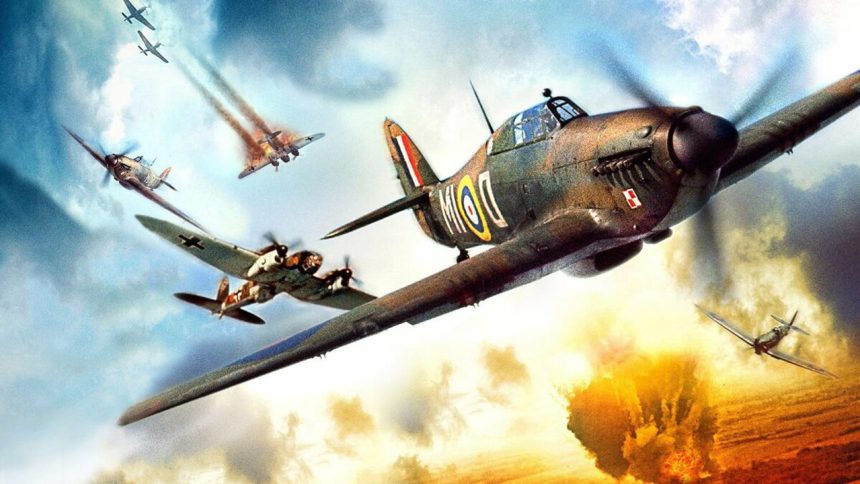On Sept. 15, 1969, cinema audiences were treated to a dramatic portrayal of the famed Battle of Britain of 1940. Made long before CGI was possible, the production of the film was an incredible feat involving around one hundred real aircraft.
Released twenty nine years after the real events of the Battle of Britain took place, the movie production, directed by Guy Hamilton, could spare no effort or expense in their attempt to recreate scenes from the summer months of 1940. Many of those who would watch the film had experienced the battle themselves from various perspectives. Indeed, several of the actors starring in the production had themselves been called into military service during the Second World War.
Complicated computer graphics were still decades away, and while scale models could be constructed and made to look very convincing, nothing but the real thing could truly replicate the sights and sounds of Second World War era aerial combat.
In total, around a hundred airframes were requisitioned for use during filming, with a large number of them being airworthy. This sizable fleet led to the film’s production garnering the tongue in cheek accolade of being the world’s 35th largest air force at the time.
Efforts to assemble the massive collection of aircraft needed for filming began in 1965. The star of the film, at least as far as aircraft are concerned, is undoubtedly the Supermarine Spitfire. An oft quoted scene even depicts the Luftwaffe Major Falke, upon being asked by Hermann Göring what he needs to win the battle, requesting “a squadron of Spitfires”. Falke was a fictional character, though inspired by real life ace Adolf Galland. Galland recalled a similar encounter with Göring in his autobiography, and also served as a consultant for the film.
No fewer than twenty seven Spitfires were used, with twelve examples being airworthy. Only two of these were strictly period accurate versions of the aircraft, so the others underwent temporary modification to make them resemble the Battle of Britain era Mark I and Mark II Spitfires. One of these two, a Mark IIa, was P7350, which actually served in the Battle of Britain, and would later fly with the Royal Air Force’s Battle of Britain Memorial Flight. It is the only airworthy Spitfire in the world today to have such a history, and its current markings pay tribute to two Battle of Britain pilots – Ken Wilkinson and Geoffrey Wellum.
Among the later variant Spitfires to appear in the film was PS853, a Spitfire PR19 delivered in 1945, now flown as G-RRGN by the Rolls-Royce Heritage Trust, as well as PS915 and PM631, both currently with the Battle of Britain Memorial Flight.
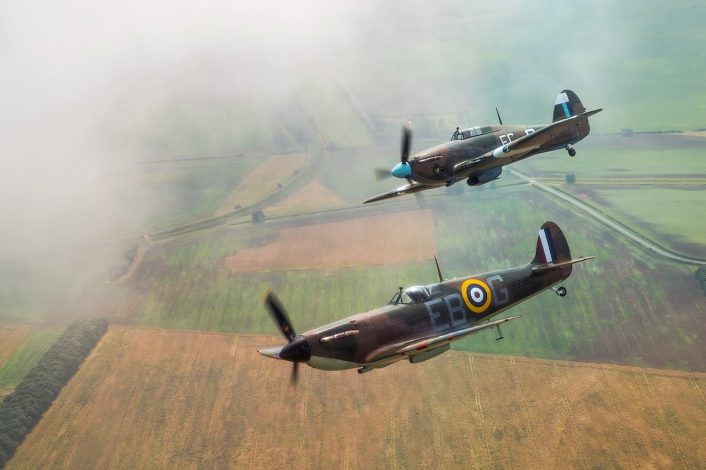
At least two more Spitfires that appeared in the film are also still airworthy to this day. Spitfire Mk IX MH434 (civilian registration G-ASJV) has an illustrious history worthy of its own article, with a number of confirmed aerial victories during its war service and multiple movie productions to its name. It later became a regular on the UK airshow circuit, including in the hands of Ray Hanna, a founding member of the Royal Air Force Red Arrows.
Another, a 1941 Spitfire Mk Ia, is AR213, now registered G-AIST. By 1941 the Mk Ia was a dated design, leading the aircraft to spend the war with training units. It was sold into civilian hands after the war ended and placed into storage. Eventually, when the Battle of Britain production was scouting for aircraft to use, G-AIST was found to be in good condition, needing only a donor spar section from another Spitfire in order to be made airworthy for filming. The airframe has since appeared in the Christopher Nolan epic Dunkirk, released in 2017.
Often regarded as the under-appreciated sibling of the Spitfire, the Hawker Hurricane was nonetheless well represented in the film, although far fewer examples of the aircraft could be made available. Six aircraft were used in total, with three being airworthy examples. Two out of these three Hurricanes still fly today with the Battle of Britain Memorial Flight, serial numbers PZ865 and LF363, both Hurricane Mk IIc variants. The third Hurricane that flew in the film operated on the Canadian civilian register as G-AWLW, but unfortunately was written off in a hangar fire in 1993. This same fire destroyed Spitfire MK297, which was also a veteran of the film production.
Hurricane Mk I P2617 was one of the non-airworthy examples involved with the film, and was restored to allow it to taxi on the ground specifically for the movie. It is on display at Royal Air Force Museum London, Hendon, where it has been kept since 1972.
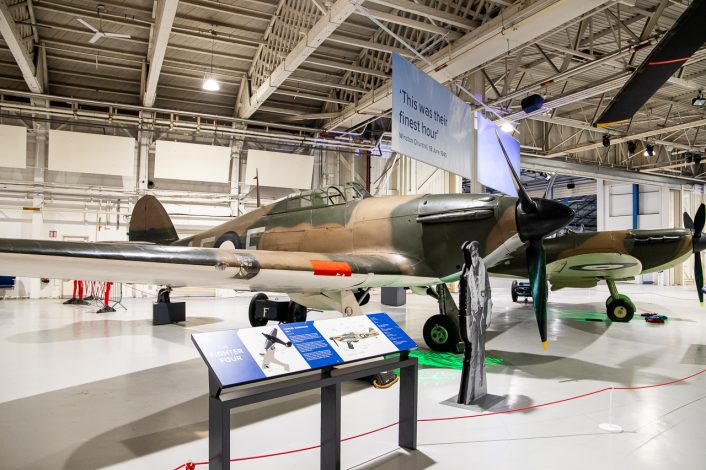
German aircraft types were more complicated to procure as so many were destroyed, and post-war attitudes in Axis power countries were, for obvious reasons, not as conducive to commemorating the war by preserving and flying aircraft types from it. In addition, the status of East Germany as part of the Soviet bloc eschewed much hope that there might have been aircraft available from there.
In the end, the filmmakers turned to Spain, who had procured many German aircraft types in license-built form. As an officially neutral country during the Second World War, many aircraft survived and some were indeed still in military service.
Twenty seven HA-1112 Buchons, licensed copies of the Messerschmitt Bf 109 built by Hispano Aviación, were earmarked by the production, with seventeen flyable. Although their fuselage profile differed from the Bf 109, as the Buchon was instead fitted with the British Rolls-Royce Merlin engine, new paint schemes and other small visual modifications to armaments and aircraft configurations were made to make them appear as close as possible to early war Bf 109s.
Many of these Buchons were actually purchased outright by the production and listed on the UK register in their name, and there was in fact such a surplus of them compared to the relatively rare Hurricanes that a number were instead painted in RAF colours and used as Hurricanes. This is most apparent in the scene featuring Polish pilots during a training mission, with the three aircraft closest to the camera being the genuine article, and the three to the rear actually being Buchons.
Aircraft C.4K-112, registered for the film as G-AWHC, was a two seater aircraft and flown during production by Adolf Galland, who used it to offer a backseat ride to former RAF pilot Robert Stanford Tuck. The two became close friends during their time on set. This two seater was one of six Buchons given to stunt coordinator Wilson ‘Connie’ Edwards, along with a Spitfire and a P-51 Mustang, as his payment for working on the film. These aircraft remained in his collection until they were sold in 2014. Many other Buchons, both from and outwith the film production, survive to this day, often representing Bf 109s, in no small part due to Hispano Aviación’s continued production of the aircraft into the post-war period.
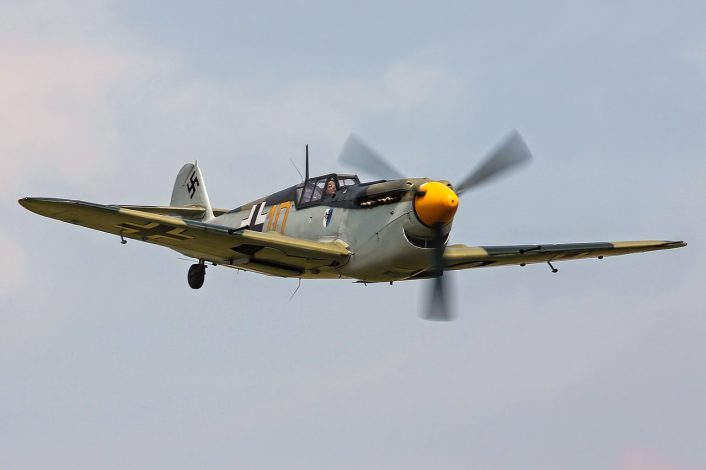
A genuine Messerschmitt Bf 109 was made available by the Royal Air Force, who used the aircraft for display purposes, but it did not end up in the film. This aircraft is now displayed by the Royal Air Force Museum.
For the infamous Junkers Ju 87 Stuka, no airworthy examples existed at all, and very few existed complete anywhere. An early plan to modify Percival Proctors, nicknamed Proctukas, to resemble Stukas was deemed not suitable. One complete Stuka was owned by the UK Ministry of Defence, who gave permission to restore the aircraft to flight. Initial examinations were promising, with the engine able to be started without any repair work at all, but the endeavor was nonetheless deemed too costly. All representations of the Stuka in the film were therefore scale models.
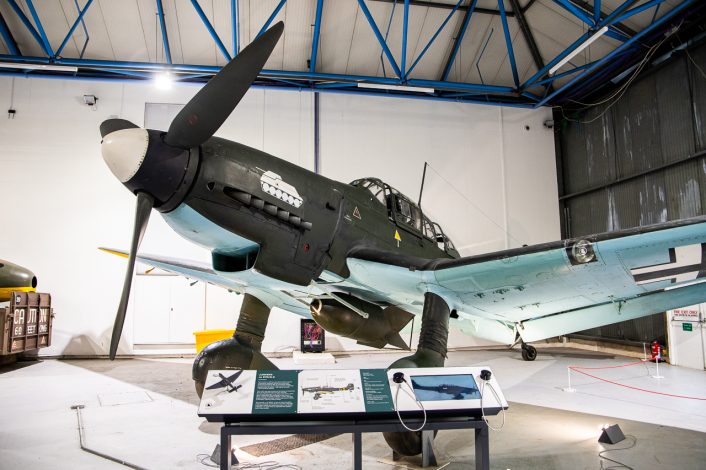
Similar to the Bf 109, the Heinkel He 111 was largely represented by a Spanish license-built version called the CASA 2.111. A remarkable thirty two of these were reportedly available for filming, though only two airframes known to have taken part have confirmable locations today as many were subsequently returned to the Spanish Air Force. Some, which were sold on in the 1970s following the withdrawal from Spanish service, were unfortunately lost in crashes.
Airframe B.2I-77 was registered as G-AWHA and has been on display at Deutsches Museum Flugwerft Schleissheim, Germany, since 1992, and B.2I-103 is at Kent Battle of Britain Museum, located at the former RAF Hawkinge.
Again, a genuine Heinkel He 111 was available from the Royal Air Force’s collection, albeit a non-airworthy example. Records suggest this aircraft was used for some in-cockpit filming sequences. The airframe is a Heinkel He 111H-20/R1 from 1944, configured as a paradrop aircraft. It is now on display at the Royal Air Force Museum, Hendon.
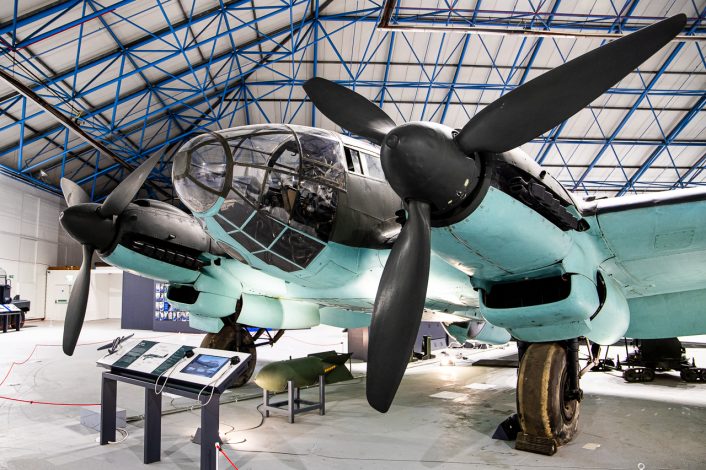
Though far from a Battle of Britain type, not entering service even with the US until 1941, the North American B-25 Mitchell nonetheless played an important role in filming. Painted with garish bright orange paint for high visibility, the Mitchell garnered the nickname ‘Psychedelic Monster’. Aiming windows for the various self-defence guns were replaced by clear, flat plexiglass panels to allow for the aircraft’s use as a camera ship. The bomb bay housed another camera, which was able to extend outwards on an arm and film from below the aircraft with a 360 degree field of view. Filmmakers were able to use the aircraft’s topside observation dome for directing the various action scenes by radio as they unfolded in the air in real time.
The B-25 used in this role was N6578D, flown by Jeff Hawke and Duane Egli. The airframe returned to the US after production wrapped, and most recently was noted as under restoration in Australia.
Battle of Britain remains, in this author’s eyes, one of the most spectacular and interesting war movies of all time. A star studded cast featuring Michael Caine, Robert Shaw, Curt Jurgens, Laurence Olivier, Susannah York and Christopher Plummer, alongside contributions from real Battle of Britain veterans like Douglas Bader, Adolf Galland, Hugh Dowding, and Bill Foxley, make the film a visceral and compelling account of one of the world’s most famous, and arguably most consequential, battles across any domain.

